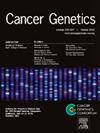鞣花酸抑制EZH2:一种潜在的癌症表观遗传治疗分子
IF 2.1
4区 医学
Q4 GENETICS & HEREDITY
引用次数: 0
摘要
表观遗传过程的失调,以异常的DNA甲基化模式和组蛋白修饰为特征,是癌症的一个标志,通过沉默肿瘤抑制基因或激活癌基因来驱动其发生、进展和转移。EZH2(增强子Zeste同源物2)对组蛋白修饰如H3K27me3的扰动在这些表观遗传改变中发挥重要作用,破坏正常基因表达,促进癌基因激活,同时抑制肿瘤抑制基因。因此,靶向参与DNA甲基化、组蛋白修饰或染色质重塑的酶的抑制剂,如PRC (Polycomb suppressupprescomplex)复合物,是很有前途的抗癌药物,其中一些正在进行临床前和临床试验。研究设计/方法采用Schrödinger软件对鞣花酸(EA)与EZH2的分子相互作用进行分子对接。通过表面等离子体共振和分子动力学模拟研究确定了EA与EHZ2的结合。体外甲基化和酶联免疫吸附测定证实了其抑制潜能。采用MTT法测定- ea -对肿瘤细胞株生长和增殖的影响。溴化乙啶和吖啶橙(EB/AO)双染色、菌落形成实验、细胞周期和细胞凋亡实验均证实了EA的作用,并在小鼠体内异种移植实验中显示了EA的抗癌潜力。EA与EZH2相互作用强烈,通过π-阳离子相互作用和氢键结合到EZH2的活性位点。分子动力学模拟和表面等离子体共振研究证实了EA的强结合亲和力,KD值为3.28E-06。体外实验通过降低H3K27me3水平,诱导自噬和凋亡,证实了对EZH2的抑制作用。使用小鼠异种移植物的体内研究进一步表明,口服EA后肿瘤大小明显减小,增殖标记Ki67和组蛋白抑制标记的表达降低。结论EA对EZH2的抑制作用可用于开发乳腺癌治疗药物。本文章由计算机程序翻译,如有差异,请以英文原文为准。

Ellagic acid inhibits EZH2: a potential epigenetic therapeutic molecule for cancer
Background
Dysregulation of epigenetic processes, characterized by aberrant DNA methylation patterns and histone modifications, is a hallmark of cancer, driving its initiation, progression, and metastasis by silencing tumor suppressor genes or activating oncogenes. Perturbations in histone modifications such as H3K27me3 by EZH2 (Enhancer of Zeste homolog 2) play significant roles in these epigenetic alterations, disrupting normal gene expression and facilitating oncogene activation while suppressing tumor suppressor genes. Consequently, inhibitors targeting enzymes involved in DNA methylation, histone modification, or chromatin remodeling, such as PRC (Polycomb Repressive Complex) complexes, are promising anti-cancer agents, with several undergoing pre-clinical and clinical trials.
Study Design/ Methods
The molecular interaction of ellagic acid (EA) with EZH2 was determined by molecular docking using the Schrödinger suite. The binding of EA with EHZ2 was determined by Surface Plasmon Resonance and molecular dynamic simulation studies. In vitro methylation followed by ELISA confirmed the inhibitory potential. Effect of -EA- on the growth and proliferation of the cancer cell lines were determined using the MTT assay. The Ethidium Bromide & Acridine Orange (EB/AO) double staining, colony formation assay, cell cycle and apoptosis assays demonstrated the effect of EA. In vivo mouse xenografts revealed the anticancer potential of EA.
Results
Screening of a phytochemical library revealed EA as an effective inhibitor of EZH2. EA interacts strongly with the EZH2, binding to its active sites through π-cation interactions and hydrogen bonds. Molecular dynamic simulation and Surface Plasmon Resonance studies confirmed potent binding affinities of EA, with KD values of 3.28E-06. In-vitro assays validated inhibitory effects on EZH2 by reducing the H3K27me3 levels and induction of autophagy and apoptosis. In- vivo studies using mouse xenografts further demonstrated significant tumor size reductions upon oral administration of EA, with decreased expression of the proliferative marker Ki67 and histone repressive marks.
Conclusion
Taken together we showed that inhibition of EZH2 by EA could be used to develop breast cancer therapeutic drug.
求助全文
通过发布文献求助,成功后即可免费获取论文全文。
去求助
来源期刊

Cancer Genetics
ONCOLOGY-GENETICS & HEREDITY
CiteScore
3.20
自引率
5.30%
发文量
167
审稿时长
27 days
期刊介绍:
The aim of Cancer Genetics is to publish high quality scientific papers on the cellular, genetic and molecular aspects of cancer, including cancer predisposition and clinical diagnostic applications. Specific areas of interest include descriptions of new chromosomal, molecular or epigenetic alterations in benign and malignant diseases; novel laboratory approaches for identification and characterization of chromosomal rearrangements or genomic alterations in cancer cells; correlation of genetic changes with pathology and clinical presentation; and the molecular genetics of cancer predisposition. To reach a basic science and clinical multidisciplinary audience, we welcome original full-length articles, reviews, meeting summaries, brief reports, and letters to the editor.
 求助内容:
求助内容: 应助结果提醒方式:
应助结果提醒方式:


